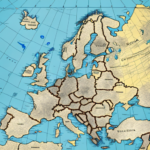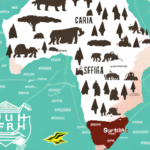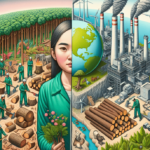Overview of International Paper and Georgia-Pacific
The paper industry is dominated by two major competitors: International Paper and Georgia-Pacific. Understanding their histories, market positions, and strategies provides valuable insights into the dynamics of this sector.
Historical Background
International Paper
Founded in 1898, International Paper has grown into one of the world's largest paper companies. Their diverse product range includes packaging, pulp, and various paper products, with operations spanning North America, Europe, Latin America, Russia, Asia, and North Africa.
Georgia-Pacific
Georgia-Pacific was established in 1927 and is renowned for its consumer products like paper towels and toilet paper. Additionally, they produce building materials such as plywood and gypsum, operating primarily in North America and Europe.
Current Market Position
As of 2023, International Paper boasts a market capitalization exceeding $22 billion, operating in over 25 countries with approximately 50,000 employees and generating over $22 billion in revenue in 2022. In contrast, Georgia-Pacific has a market capitalization of around $8 billion, employs about 30,000 people, and reported revenues exceeding $20 billion in 2022, with approximately 85% derived from consumer products.
Both companies prioritize sustainability, with International Paper aiming to reduce greenhouse gas emissions by 20% by 2030 and Georgia-Pacific committing to sourcing 100% of their fiber from certified sustainable sources by 2025. These initiatives not only mitigate environmental impact but also appeal to eco-conscious consumers and investors.
Financial Performance Comparison
Revenue and Profitability
International Paper has consistently outperformed Georgia-Pacific in financial metrics. In 2022, International Paper reported an operating income of over $3 billion and a net profit margin of 6.2%. Their return on equity (ROE) stood at 15.3%, reflecting strong profitability.
Georgia-Pacific, while robust, reported an operating income of approximately $2 billion and a net profit margin of 5.0%, with an ROE of 10.1%. The difference is largely attributed to International Paper's emphasis on cost-cutting and operational efficiency.
Cost Management and Innovation
International Paper's focus on optimizing supply chains and enhancing manufacturing processes has contributed to its superior financial performance. Moreover, significant investments in research and development have led to innovative, sustainable packaging solutions.
Georgia-Pacific faces challenges in cost reduction due to its diversified business portfolio, encompassing consumer products, building materials, and packaging. However, recent investments in new technologies aim to improve efficiency and reduce operational costs.
Products and Services
International Paper
- Containerboard and corrugated boxes
- Office and printing papers
- Recycling services
- Specialty papers for food packaging, labels, and medical use
- Pulp products including fluff pulp and market pulp
Georgia-Pacific
- Consumer paper products: paper towels, toilet paper, napkins
- Building materials: plywood, gypsum, lumber
- Chemical products: adhesives and resins for construction and automotive industries
- Foodservice solutions: disposable cups and plates
Market Share and Competitive Landscape
International Paper holds a 25% market share in the containerboard industry and is the largest producer of uncoated freesheet paper in North America. Meanwhile, Georgia-Pacific dominates the consumer paper products sector with well-known brands like Brawny, Angel Soft, and Quilted Northern.
Both companies are expanding their market shares through strategic acquisitions and sustainability initiatives. For instance, International Paper's acquisition of Weyerhaeuser's pulp business in 2016 enhanced its presence in the tissue and towel market.
The industry faces intense competition from digital media, which has reduced demand for products like newsprint. However, the shift towards specialty and sustainable paper products presents growth opportunities.
Strengths, Weaknesses, Opportunities, and Threats (SWOT)
International Paper
- Strengths: Diverse product portfolio, global presence, strong financial performance.
- Weaknesses: Overreliance on the containerboard segment.
- Opportunities: Expansion in Asia, growth in value-added products.
- Threats: Declining demand due to digital media, raw material price volatility.
Georgia-Pacific
- Strengths: Strong brands, dominant market share in consumer paper products.
- Weaknesses: Limited geographic presence, narrow product range.
- Opportunities: Expansion in e-commerce, growth in building materials segment.
- Threats: Similar to International Paper, including digital media impact and raw material costs.
Growth Strategies and Future Prospects
International Paper
- Expanding global presence, particularly in Asia.
- Investing in sustainable and innovative product development.
- Strategic acquisitions to enhance market share.
Georgia-Pacific
- Enhancing e-commerce capabilities.
- Launching new consumer products.
- Investing in the building materials segment to diversify revenue streams.
Both companies are expected to continue their growth through strategic investments and sustainability efforts. However, ongoing challenges such as digital media trends and environmental regulations will influence their trajectories.
Technological Advancements and Industry Impact
Technological innovations like digital printing and automation are transforming the paper industry. Both International Paper and Georgia-Pacific are adopting advanced technologies to improve operational efficiency, reduce costs, and develop eco-friendly products. These advancements are essential for maintaining competitiveness in a rapidly evolving market.
Future Mergers and Acquisitions
Given the competitive landscape, future mergers or acquisitions are plausible as both companies seek to strengthen their market positions. Any potential deals would likely focus on expanding product portfolios, entering new markets, or enhancing sustainability initiatives. Strategic partnerships could also emerge to address the challenges posed by digital transformation and environmental concerns.
Conclusion
The competition between International Paper and Georgia-Pacific significantly shapes the paper industry. Their strategies in sustainability, innovation, and market expansion not only drive their individual successes but also influence industry trends and consumer offerings. As the sector continues to evolve, these companies will play pivotal roles in adapting to new challenges and opportunities.






















